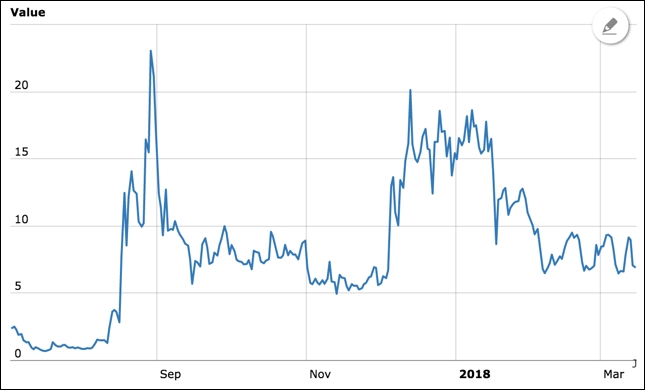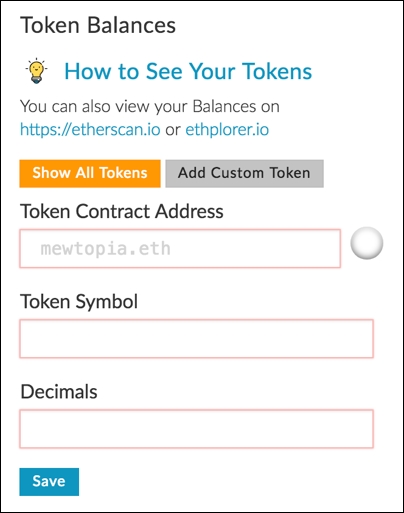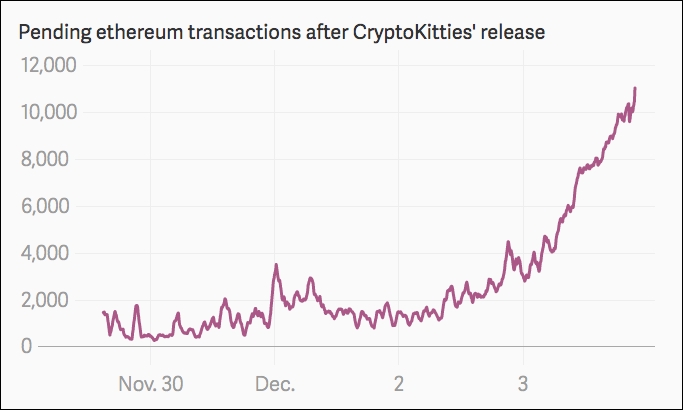When the ICO wave hit its peak in 2017, there was a mad rush to learn what was going on and how it all worked. Many people followed instructions issued by the company on how to buy into the ICO, but it was a very new and often complicated process. It involved sending bitcoin or ether to a given address that was published on a bitcointalk forum, on a Slack channel, or on the official website.
Take, for example, the Monaco ICO. An investment of one ether would return 150 MCO tokens. Monaco opened the ICO on May 18, 2017, when 1 ether was about $100 USD. This meant that one MCO was the equivalent of $1.50 USD.
The ICO finished on June 17, and about a month later, it listed on exchanges. By the end of August, it had very quickly shot up to $22 USD. The 150 MCO tokens would now be worth $3,300. That is a whopping 1,366% increase.

Figure 10: Monaco price chart showing volatile swings (https://www.worldcoinindex.com/coin/monaco)
The success story being shared was that the tokens would "moon" after listing on exchanges and large profits could be made.
Monaco was not an exception to the rule. This was common of many ICOs in the early days. Supporters would believe in the project, everything was open and transparent, and there was often a noble cause. This is essentially how the fire started and towards the end of 2017, ICOs were popping up like hotcakes. In the early days, though, participating in these ICOs was a challenge.
The first challenge around participating in ICOs was where to buy the cryptocurrencies from because most ICOs only accepted ether. Initially, this would occur face-to-face, with a willing seller in the local community, but nowadays, there are easier and quicker ways. There are many exchanges around the world that once registered, with some form of driver's license or passport ID, along with a photo of oneself holding a piece of paper with a written statement of some sort, the cryptocurrencies can be purchased. It is important to note that today, ICOs accept all kinds of payment, including bank transfers!
The next challenge was where to store the ether. Typical places would be a mobile wallet, a desktop wallet, or a hardware wallet. A popular wallet for storing tokens was MyEtherWallet and many ICOs would recommend using MyEtherWallet, especially due to the usability, accessibility, security, and therefore the popularity.
Tokens would be distributed soon after the ICO had ended and needed to be claimed. This process often involved being provided with the smart contract address and having to add the custom token to MyEtherWallet manually. This was not an easy process for anyone new in the crypto space.

Figure 11: Adding ICO tokens to MyEtherWallet was often a technically complicated task
There is a certain thrill in speed-seeking adventures and the same can be said about ICOs raising millions of dollars in seconds. A traditional venture capital raise can take anywhere between weeks to many months of negotiations. In this new world of ICOs, if the fundamentals have been executed correctly, a lot of money can be raised in a very short space of time.
For instance, Brave topped the list, raising $35 million USD in only 30 seconds! That works out to an astonishing $4.2 billion USD an hour. Filecoin managed $200 million USD in one hour and Firstblood and SingularDTV finished their ICOs in 10 minutes and 17 minutes respectively. Some figures can be seen in the following table:
|
Date |
ICO |
Raised |
Duration |
Rate |
|
May, 2017 |
Brave |
$35M |
30 seconds |
$4,200M/hour |
|
Aug, 2017 |
Filecoin |
$200M |
60 minutes |
$200M/hour |
|
Feb, 2017 |
Melonport |
$2.9M |
3 minutes |
$58M/hour |
|
Sep, 2016 |
Firstblood |
$5.5M |
10 minutes |
$33M/hour |
|
Oct, 2016 |
SingularDTV |
$7.5M |
17 minutes |
$26.5M/hour |
|
Nov, 2016 |
Golem |
$8.6M |
29 mins |
$17.2M/hour |
|
May, 2017 |
Storj |
$20M |
6 hours |
$3.3M/hour |
|
Sep, 2017 |
KyberNetworks |
$48M |
24 hours |
$2M/hour |
|
Apr, 2014 |
MaidSafe |
$6M |
5 hours |
$1.2M/hour |
|
June, 2017 |
Civic |
$33M |
2 days |
$0.69M/hour |
|
June, 2017 |
SONM |
$42M |
4 days |
$0.58M/hour |
|
Mar, 2016 |
DigixDao |
$5.5M |
12 hours |
$0.46M/hour |
While these numbers may seem impressive and make great click-bait headlines, there are several disadvantages. Firstly, a 30-second sellout tends to mean a few buyers purchasing substantial amounts. There were only around 130 people that managed to buy Brave tokens, with five buyers scooping up half the supply. This is undesirable because these "whales" can later on flood the market and potentially crash the price of the token. This is in contrast to Status or KyberNetworks, which have over 20,000 contributors.
The entire ethos of the ICO community is to allow a large group of genuine users to help support a project they believe in, and become long-term users and advocates. Investors are generally short-term holders looking to make a profit. It's called the flipping game.
To increase the number of contributors, many ICOs put strategies in place. The most obvious method was to limit each token purchase. This was easily circumvented by making lots of small transactions, which then skewed the statistic. It also put unnecessary stress on the Ethereum network and made contribution numbers look higher than they actually were.
Status, a decentralized messaging platform mentioned above, ran an ICO in June 2017 and overloaded the network as thousands of investors, supporters, and contributors wanted to participate. The transaction numbers increased to over three-and-a-half times what Ethereum could normally handle. (https://www.dashforcenews.com/ico-mania-grinds-ethereum-halt-scaling-issues-not-limited-bitcoin/). Contributors then resorted to increasing the transaction fees in order to jump the queue. In another instance, a user lost more than $80,000 USD worth of ether in the AirSwap ICO, due to a failed transaction (https://www.ccn.com/this-airswap-ico-investor-lost-80000-ona-failed-transaction/). These stories were common during the second half of 2017 and highlighted the challenges of running ICOs with huge user demand tied to FOMO (pronounced pho-mo), Fear of Missing Out.
In December 2017, while there was a slight slowdown in ICO offerings, another experiment hit the crypto world: CryptoKitties. The concept was that users could not only buy CryptoKitties, which represented a digital asset on the blockchain, but they could actually breed them as well. A CryptoKitty would be generated every 15 minutes for one year and then afterwards, the increase in the population would come from breeding. These CryptoKitties were the first non-fungible digital asset on the blockchain.

Figure 12: Astoundingly, CryptoKitties could be bred on the blockchain creating more CryptoKitties
There was a concern that the CryptoKitties experiment, essentially a blockchain gamification version of the popular Tamagotchi in the late 1990s, was diverting developer attention away from solving more serious business applications and real-world problems. The creators disagreed and argued in their cleverly titled "White Pa-Purr" that the purpose was that education, accessible user experience, and practical applications were the missing factors for broader adoption.

Figure 13: Transaction volumes spike due to CryptoKitties (https://qz.com/1145833/cryptokitties-is-causing-ethereum-network-congestion/)
Regardless of whether the network was congested with ICOs or virtual CryptoKitties, the fact was that the network was still being experimented on, challenges were being discovered, and potential solutions proposed to improve the underlying infrastructure and network.
The Useless Ethereum Token was the epitome of the ICO hype. Money was being thrown into companies offering tokens by people who were not even reading what the project was about. One project, actually one website called the Useless Ethereum Token, was set up in June 2017, allowing people to buy tokens. The website clearly stated that these tokens were not worth anything, didn't represent anything, and if purchased, the funds raised would be used to buy electronics. It even said not to buy these tokens.

Figure 14: A warning from the Useless Ethereum Token website that many ignored (https://uetoken.com/)
What was the end result? Astoundingly, 310 ether, or over $273,000 USD, was raised! The irony is that now, to buy the electronics or a "big-screen television," the 310 ether would need to be sold at an exchange and converted back to fiat currency, and that would involve our dear friends the banks. With all the Anti-Money Laundering (AML) and Know Your Customer (KYC) requirements, that will be another challenge in itself. The other option, of course, would be for the person to keep the ether and use it to pay for groceries or utility bills because there are places where you can do this, such as livingroomofsatoshi.com.

Figure 15: The Useless Ethereum Token ended up raising over $270,000 USD
Network congestion or FOMO meant that 2016 and 2017 were years like no other. There's a movie to be made about this somewhere but in the meantime, all the action can be relived through the bitcointalk forums, provided for over 40 ICOs at theicotrain.com.
